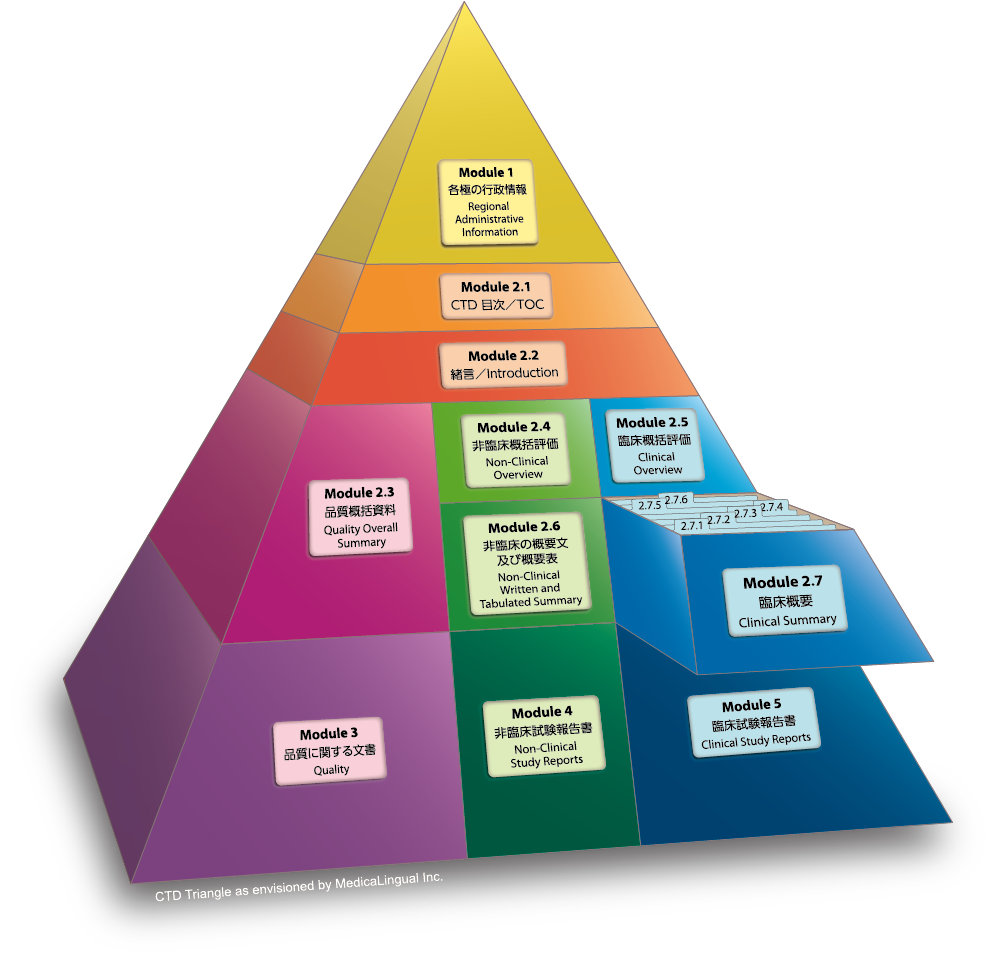
薬生薬審発0202第1号(平成29年2月2日)
ICH HARMONISED GUIDELINE- M4E(R2) – Dated 15 June 2016
Module 2.7 臨床概要
2.7.2 臨床薬理の概要
2.7.2.3 全試験を通しての結果の比較と解析
本項では、当該医薬品のPK、PD、PK/PD関係を特徴づけるために実施したin vitroヒト生体試料試験、PK、PD、PK/PD試験の全ての結果を用いること。これらの結果のうち、個体内及び個体間変動に関する成績、これらのPK関係に影響を及ぼす内因性及び外因性要因について示すこと。
Module 2.7 CLINICAL SUMMARY
2.7.2 Summary of Clinical Pharmacology Studies
2.7.2.3 Comparison and Analyses of Results Across Studies
This section should use the results of all in vitro human biomaterial studies and PK, PD and PK/PD studies to characterise the PK, PD and PK/PD relationships of the drug. Results related to the inter- and intra-individual variability in these data and the intrinsic and extrinsic factors affecting these pharmacokinetic relationships should be discussed.
本項では、通常は文章と表を用いて、以下の事柄に関する全ての試験データを事実に基づいて示すこと。
- In vitro薬物代謝試験及びin vitro薬物相互作用試験の結果及びその臨床的な意味。
- 標準的なパラメータの最良推定値及び変動要因の記載を含むヒトPK試験。対象疾患の患者集団及び特別な患者集団(例:小児、高齢者、腎障害や肝障害を有する患者)における用量及び用量調整を裏付けるデータに重点を置くこと。
- 単回投与時と反復投与時とのPKの比較。
- 外因性要因又は内因性要因によると思われるPK又はPDの個体間変動を検討するために、複数の試験において実施された少数サンプリングに基づく結果等のポピュレーションPK解析。
- 用量-反応又は濃度-反応関係。ここでは、重要な臨床試験で用いた投与量と投与間隔の選択を裏付けるデータに重点を置くこと。なお、添付文書案中の用法・用量を裏付ける情報については、第2.7.3.4項に示すこと。
- ヒト生体試料試験、PK試験又はPD試験から得られた結果における大きな矛盾点。
- 外国臨床データが新地域に外挿できるかどうかを決定するために実施されたPK試験(ICH E5参照)。地域又は人種間のPKデータの類似性に関する試験結果及び解析結果を本項に要約すること。PDバイオマーカーを用いる試験(しかし臨床的有効性は評価しない)は同様に本項で要約してよい。また、独立した下位の項を作り、これらの種類のデータを要約してもよい。
This section (typically with the use of text and tables) should provide a factual presentation of all data across studies pertinent to the following:
- in vitro drug metabolism and in vitro drug-drug interaction studies and their clinical implications.
- human PK studies, including the best estimates of standard parameters and sources of variability. The focus should be on evidence supporting dose and dose individualisation in the target patient population and in special populations, e.g., paediatric or geriatric patients, or patients with renal or hepatic impairment.
- comparison between single and repeated-dose PK
- population PK analyses, such as results based on sparse sampling across studies that address inter-individual variations in the PK or PD of the active drug substances that may be due to extrinsic or intrinsic factors.
- dose-response or concentration-response relationships. This discussion should highlight evidence to support the selection of dosages and dose intervals studied in the important clinical trials. In addition, information that supports the dosage instructions in the proposed labelling should be discussed in Section 2.7.3.4.
- major inconsistencies in the human biomaterial, PK, or PD database.
- PK studies that were performed to determine whether foreign clinical data could be extrapolated to the new region (see ICH E5). The result of the studies and analysis of the similarity of the PK data between regions or races should be summarised in this section. Such studies that use PD biomarkers (but do not evaluate clinical efficacy) may similarly be summarised here. An independent subsection can be created to summarise these kinds of data.










